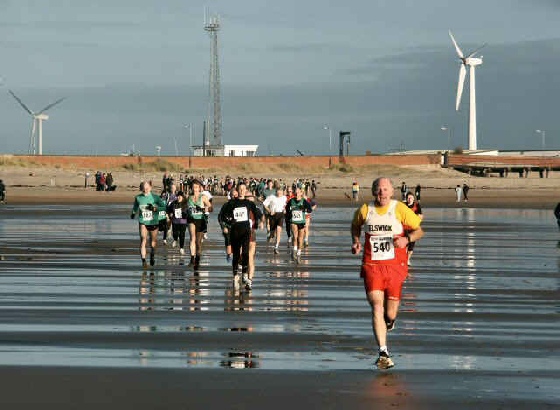





© 2016 Blyth Running Club All Rights Reserved
Blyth Sands Race
Organised by the Club, the Sands Race is held along the beach from Blyth to Seaton Sluice and back again. This is an annual event, handicapped by age and sex and held on the first Sunday in December. See the article below the picture for a history of the Sands Race.
The 2022 Sands Race was held on Sunday 4th December at 10:00 am
History of Blyth Sands Race
(Article written by George Young)
In the late 1950’s members of Blyth Rowing Club regularly ran along the beach in the winter months with the local harriers. The rowers club house was an ideal meeting place and over hot cups of tea a challenge was issued. The Pearson brothers, Jim, Tom and Doug, county rowers claimed that with a handicap ( a few minutes start) they could produce a team that would beat the runners. The race was to be run from Blyth Harbour across the bay to Seaton Sluice, around an upright oar, then back – a distance of about five miles.
The challenge was accepted and in the middle of December 1959 Jim Pearson led the rowers to a convincing victory. The handicap that the runners gave the rowers was ridiculous.
Fortyfive years on the race has continued without a break and is one of the oldest races in the region. Although runners are the only ones who compete at present the race still retains the “start “ system which makes the race an extremely exciting spectator event as the “scratch” competitors attempt to make up the stagger. Handicaps are based on the age and gender of the participant ie; Ladies over the age of 50 will receive 12 minutes start over a man aged between 18 & 39.
The earliest results are not available but there are records from 1966 and they make fascinating reading. Names like T Horne, D Coker, N Rackman and W Pickles featured again and again. Ray Caruthers of Gosforth was the fastest runner in 1967, 1974, 1977 and 1978. Reg Checkley (Heaton) fastest in 1968, Gordon Freeman (Sunderland) first veteran in 1973 and a “J Hedley” was the fastest over-
Inevitably Jim Alder has frequently won the race and as part of his training he would run to Blyth Beach from Morpeth, a distance of twelve miles, take part in the race then run home again. Jimmy broke the record in 1964 when he ran 25.26 and this stood for eight years before two emerging Elswick Harriers appeared on the scene.
Dave Gibbon and Mike McLeod entered the 1970 race as teenagers and were placed seventh and eighth respectively behind the winner R Balding of Heaton. In 1971 McLeod was to win the race but a year later Gibbon took the title in a record time of 25.20 and went on to confirm dominance in 1973 with a victory, again inside Alder’s old time. McLeod did not race on these last two occasions and neither runner competed in 1974.
However, in 1975 they were back again in a head-
The route varies from day to day and this gives the run a certain novelty. It is not possible ‘to go around’ the course as it changes by the hour. At low tide the sand is compacted and firm to run on, although the weather can turn this into ‘ripples’ like corrugated roofing – much worse than the ‘London cobbles.’ Or when the sea has been particularly wild the surface can be dredged exposing rocks and even the concrete, defensive blocks from the war.’
And of course there are the groynes. ‘Groyne strain’ is a unique injury associated with this event. These piers (four in all) can be a short step-

BRC Members please note: The Club always require marshals, timekeepers, tea-
Unique staggered start:
- Ladies O/75 -
15 Minutes start - Ladies O/70 -
14 Minutes start - Ladies O/65 & Men O/80 -
13 Minutes start - Ladies O/60 & Men O/75 -
12 Minutes - Ladies O/55 & Men O/70 -
11 Minutes - Ladies O/50 & Men O/65 -
9 Minutes - Ladies O/45 -
8 Minutes - Ladies O/40 & Men O/60-
7 Minutes - Ladies O/35 & Girls U/18 -
6 Minutes - Men O/55 -
5 Minutes - Senior Ladies & Men O/50 -
4 Minutes - Men O/45 -
3 Minutes - Men O/40 & Boys U/18-
2 Minutes - Senior Men -
Scratch
